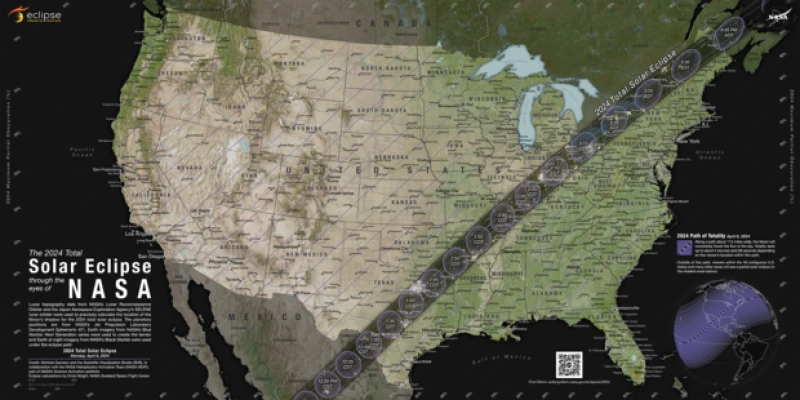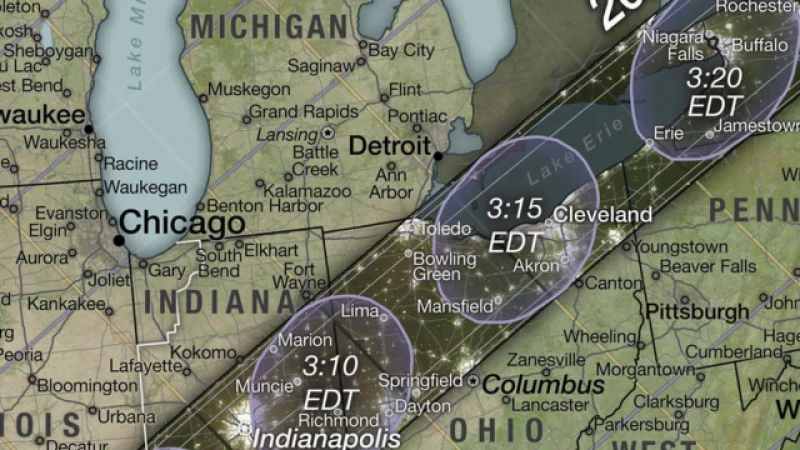The 2024 solar eclipse will be visible across North America today. As the moon's position between the Earth and sun casts a shadow on North America, that shadow, or umbra, will travel along the surface from west to east at more than 1,500 miles per hour along the path of totality.
That means the eclipse will start, peak and end at different times — as will the moments of total darkness along the path of totality — and the best time to view the eclipse depends on where you are located. Some places along the path will have more totality time than others.
What time does the 2024 total solar eclipse start?

The total solar eclipse will emerge over the South Pacific Ocean before the shadow falls across North America, beginning in parts of Mexico. The path of totality, where onlookers can witness the moon fully blocking the sun (through eclipse viewing glasses for safety), is expected to first make landfall near the city of Mazatlán around 9:51 a.m. MT.
The total solar eclipse will cross over the U.S.-Mexico border into Texas, where it will emerge over Eagle Pass at 12:10 p.m. CT.
In Dallas: NASA data shows the partial eclipse will first become visible at 12:23 p.m. CT.
Oklahoma and Arkansas: The eclipse begins in Little Rock at 12:33 p.m. CT.
Cleveland: The eclipse will begin at 1:59 p.m. ET.
Buffalo, New York: Darkness will start spreading over the sky at 2:04 p.m. ET.
Vermont: The eclipse will reach northwestern Vermont, including Burlington, at 2:14 p.m. ET.
New Hampshire and Maine: Parts of these states will also follow in the path of totality before the eclipse reaches the Canadian mainland at 3:13 p.m. ET.
Washington, D.C.: The partial eclipse will start at 2:04 p.m. ET.
New York City: A substantial partial eclipse will begin at 2:10 p.m. ET.
Chicago: Viewers can start viewing the partial eclipse at 12:51 p.m. CT.
Detroit: Viewers will be able to enjoy a near-total eclipse beginning at 1:58 p.m. ET.
Boston: The eclipse will begin at 2:16 p.m. ET.
The below table by NASA shows when the eclipse will start, peak and end in 13 cities along the eclipse's path.
When Will the Solar Eclipse Reach Peak Totality?
More people will have the opportunity to witness the total solar eclipse this year compared to the last total solar eclipse visible from the U.S. in 2017.
The timing of the eclipse's peak will vary for cities within the path of totality and those outside. In areas within the path of totality, darkness will envelop the sky for a brief period. The duration of totality will range from just over 4 minutes to around 3.5-4 minutes in most locations. Cities experiencing a partial eclipse will observe a portion of the sun being obscured for over two hours.
Mazatlán is scheduled to witness totality at 11:07 am PT. Dallas will see the moon completely cover the sun at 1:40 p.m. CT. Little Rock will witness the full eclipse beginning at 1:51 p.m. CT, followed by Cleveland at 3:13 p.m. ET, and Buffalo at 3:18 p.m. ET. Totality will arrive in Burlington at 3:26 p.m. ET before progressing through the remaining states and reaching Canada around 4:25 p.m.
Outside the path of totality, Washington, D.C. will experience 87.4% coverage of the sun at 3:20 p.m. ET, while Chicago will observe maximum coverage of 93.9% at 2:07 p.m. CT. New York City will be much closer to the path of totality this year than in 2017, with 89.6% coverage expected at 3:25 p.m. EDT.
Detroit is another city that will encounter a near-total eclipse, with 99.2% maximum coverage at 3:14 p.m. ET. Boston will see 92.4% coverage at 3:29 p.m. ET.
What time will the solar eclipse end?
The eclipse will leave continental North America from Newfoundland, Canada, at 5:16 p.m. NT, according to NASA.
At the beginning of the path of totality in Mazatlán, the eclipse will be over by 12:32 p.m. PT, and it will leave Dallas at 3:02 p.m. CT. The eclipse will end in Little Rock at 3:11 p.m. CT, Cleveland at 4:29 p.m. CDT and Buffalo at 4:32 p.m. ET. Burlington won't be far behind, with the eclipse concluding at 4:37 p.m. ET.
Meanwhile, the viewing will end in Chicago at 3:21 p.m. CT, Washington, D.C. at 4:32 p.m. ET, and New York City at 4:36 p.m. ET.
In Detroit, the partial eclipse will disappear at 4:27 p.m. ET, and in Boston, it will be over at 4:39 p.m. ET.
How long will the eclipse last in total?
The total solar eclipse will begin in Mexico at 11:07 a.m. PT and leave continental North America at 5:16 p.m. NT. From the time the partial eclipse first appears on Earth to its final glimpses before disappearing thousands of miles away, the celestial show will dazzle viewers for about 5 hours, according to timeanddate.com.
The duration of the total solar eclipse varies at different points along the path, with the longest being 4 minutes and 28 seconds, located northwest of Torreón, Mexico. NASA notes that the longest periods of totality occur near the center of the path.
Compared to the 2017 eclipse, spectators will experience a much longer duration of totality today, as the longest totality during the 2017 eclipse was only 2 minutes and 32 seconds.
The moon's shadow, known as the umbra, is moving across Earth today at a speed exceeding 1,500 miles per hour, as reported by NASA. If the Earth were to rotate in the opposite direction, the shadow would move even faster.
What is the longest duration of a solar eclipse on record?
The longest total solar eclipse on record lasted 7 minutes and 28 seconds in 743 B.C. However, NASA predicts that this record will be surpassed in 2186 with a total solar eclipse lasting 7 minutes and 29 seconds. The next total solar eclipse visible from parts of the U.S. is expected to occur on Aug. 23, 2044.







